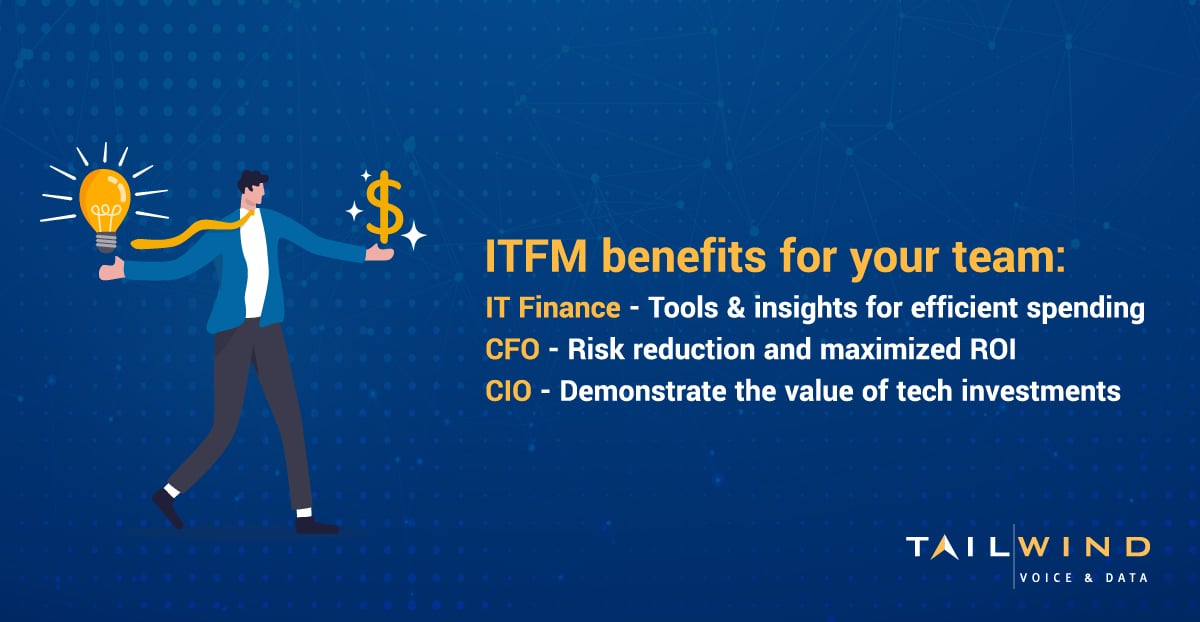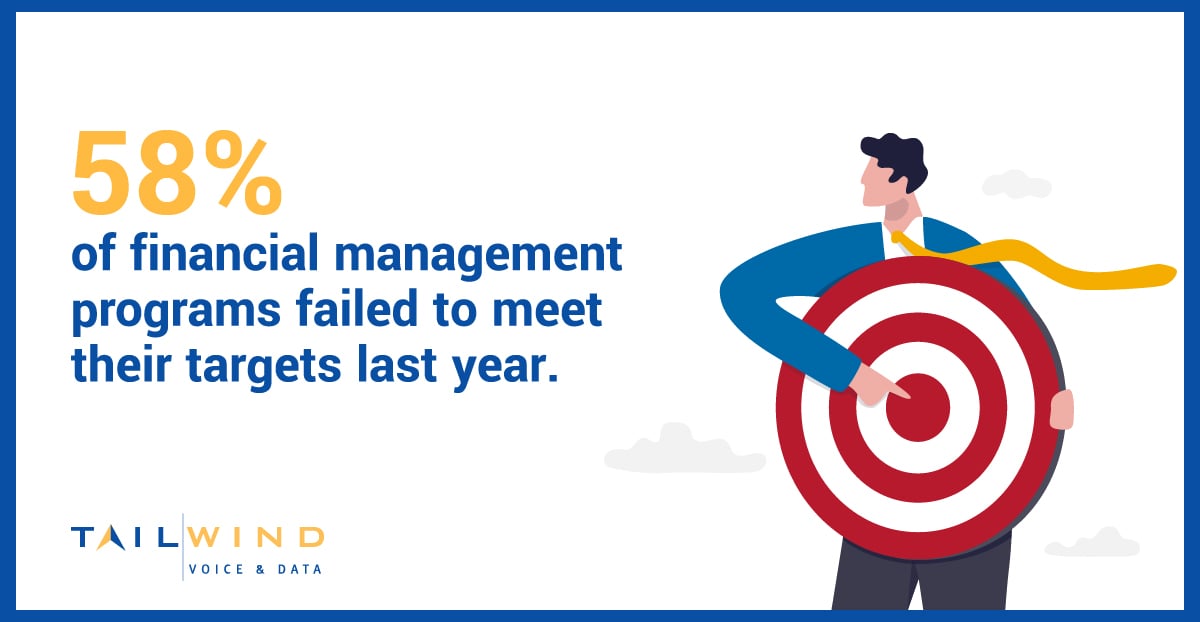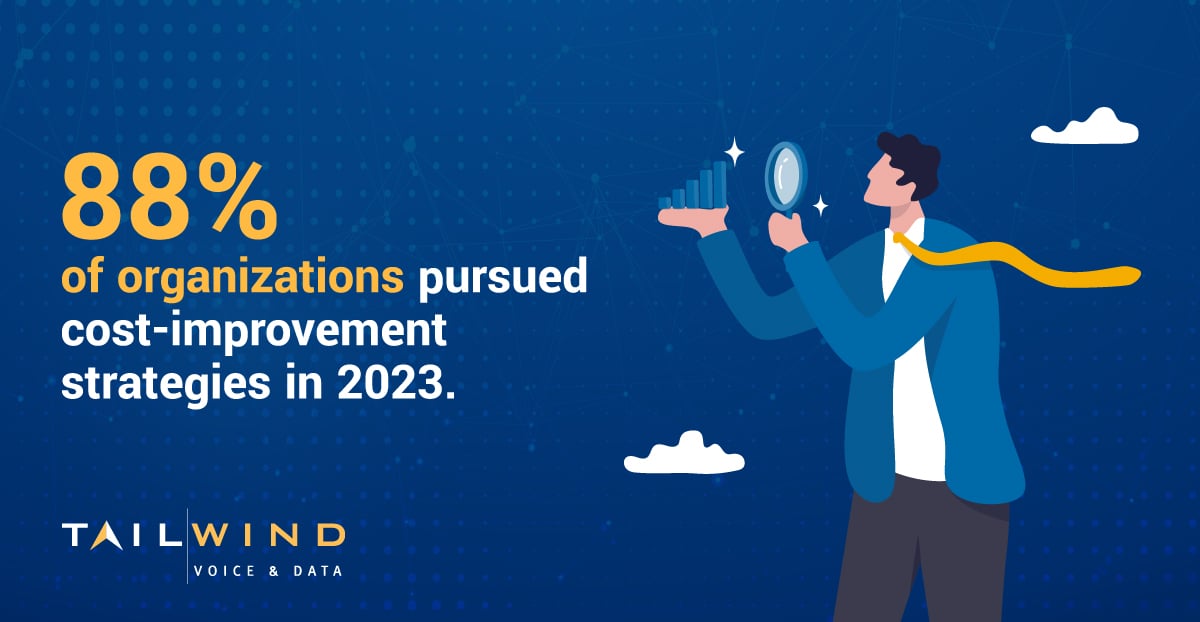IT spending continues to grow every year. In 2024, businesses are expected to spend $5.1 trillion on IT – an 8% increase from 2023.1 The hype surrounding emerging technologies like generative AI is a massive driver of this rise in spending, with 65% of IT leaders saying AI will positively impact their organization.2
With technology making up a large portion of budgets, managing IT finances is critical for business success. However, many companies struggle with this. 88% of companies planned to pursue cost improvement last year, but 58% of financial management programs failed to meet their targets.3 Without proper visibility and control over technology spending, IT leaders struggle to show how their investments deliver value – and may waste money unnecessarily.
That's where IT financial management (ITFM) comes in. Putting an effective ITFM strategy in place allows companies to optimize IT spending, gain cost transparency, demonstrate the value of investments, and make more data-driven IT decisions overall.
Read on to learn what ITFM is, why it matters for your enterprise business, and best practices to help you implement it successfully.
What Is IT Financial Management?
IT financial management refers to the processes and frameworks used to track, analyze, and optimize a company's IT spending. The goal of ITFM is to provide transparency into how much is being spent on IT, identify waste, and align technology investments with business goals.
At its core, ITFM involves budgeting, accounting, charging, and monitoring costs related to IT assets, resources, projects, and services. This includes operational expenditures (OPEX), like staffing, software licenses, and cloud subscriptions, and capital expenditures (CAPEX), such as new hardware and infrastructure.

Benefits of ITFM for Company Stakeholders
Implementing IT financial management provides specific benefits for stakeholders across the organization, including:
- IT Finance - ITFM provides IT finance teams with tools and insights to manage IT spending efficiently. It helps them identify opportunities to recover costs and ensures IT investments align with organizational goals.
- CFO - For a CFO, ITFM is about risk reduction and maximizing ROI. Effective IT financial management provides a clear view of IT spending and its impact on the company’s financial health.
- CIO - CIOs can use ITFM to demonstrate fiscal responsibility and the strategic value of the technology service portfolio to the business. It enables them to make informed decisions about IT investments based on their alignment with digital transformation objectives.
By offering cost transparency and ensuring investments align strategically, ITFM enables better collaboration among business leaders.
How Does ITFM Help Enterprises Reduce Spending?
ITFM offers comprehensive visibility into IT costs so enterprises can take targeted actions to optimize budgets and reduce waste. IT financial management tools help enterprise businesses reduce spending on IT by:
Identifying and Eliminating Waste
ITFM provides granular data on where money is spent, such as which applications, vendors, and resources cost the most. Enterprises can use this data to pinpoint redundant systems, obsolete tools, and other areas of waste. Eliminating these unnecessary expenses provides immediate cost savings.
Enforcing Accountability
By requiring detailed tagging and tracking of every IT expenditure, ITFM increases accountability. With all costs tied back to business units and budget owners, better oversight and justification are required for each item to discourage unnecessary spending.
Forecasting Accurately
Looking at historical IT spending data trends allows enterprises to better predict costs. Insights into seasonal fluctuations, upcoming projects, and other variables enable organizations to create more accurate budgets and forecasts, ultimately minimizing surprises and overages.
Negotiating Better Contracts
Leveraging data on previous vendor and subscription spending helps enterprise organizations negotiate better rates. Understanding total contract value and usage volumes puts the business in a stronger position to ask for discounts and optimized contracts.
Optimizing Asset Utilization
ITFM provides a complete inventory of IT assets. With this, enterprises can identify underutilized or unused software licenses, idle hardware, and other areas of waste. Optimizing the use of existing assets reduces the need for new expenses.

IT Financial Management Best Practices
Implementing IT financial management requires the right processes, tools, and discipline. Here are some best practices for success:
Create a Foundation for IT Finance
Document formal policies, procedures, tracking mechanisms, and financial reporting structures to account for all IT spending decisions. Establish a framework for making IT investment decisions based on ROI, TCO, and alignment with business goals, and define who is responsible for what at each step of the process. Institute budgets, forecasts, and approval processes to control spending.
Continuously Monitor IT Spending
Collect and analyze data on IT expenditures regularly to identify waste and cost optimization opportunities. Look at trends over time by category, department, and vendor, and automate data collection for real-time insights into spending.
Improve Visibility Through Reporting
Create spending reports tailored to business and IT leaders and proactively share these insights. Reports should demonstrate ROI and alignment to goals as well as provide visibility by department, project, asset type, and other cost categories.
Evaluate Investments
Require business cases, TCO analyses, and ROI projections for proposed IT investments above a set threshold. For each request, analyze if the investment will provide hard savings or productivity gains and prioritize initiatives based on ROI and alignment with strategic priorities.
Increase Accountability
Implement detailed tagging and tracking of every IT expenditure to increase accountability. By keeping track of which departments make IT purchases, you can gain more informed spending decisions and accurate forecasting to minimize unnecessary costs.
Model IT Budgets to Business Goals
Align your IT budget and strategic roadmaps to overall business strategies and initiatives. Create processes for continual collaboration between the IT department and other teams to ensure IT investments map to organizational priorities both now and in the future.
Look Ahead to Future Needs
Prioritize future business objectives and technology needs. Establish regular meetings for business and IT leaders to communicate upcoming plans and resource requirements. This keeps all stakeholders informed to prepare budgets and resources well in advance of future needs.
Creating an IT Financial Management Framework
To successfully implement IT financial management into your business strategy, you need to create a budgeting framework. While an IT budget should be developed by the CIO and CFO and informed by IT leadership, here are some common steps to help you integrate ITFM into your budgeting framework:
Define Strategic Alignment
Take stock of overall business priorities, goals, and initiatives, as your IT investments should support these. Stay on track by creating processes to evaluate alignment and effectively account for readjustments as needed.
Document Current State
Collect details on current IT assets, vendor contracts, resource allocation, spending across all domains, and more, then identify pain points within your current IT environment.
Model the Ideal Future Architecture
Map out an optimized IT environment that supports your ideal business outcomes within budget constraints. Include departmental needs, costs, and timeframes.

Analyze Build vs. Buy Decisions
For each component of the ideal architecture, analyze whether it would be more cost-effective in the long term to build key capabilities in-house or buy third-party solutions.
Create an ITFM Budget
Develop a comprehensive IT budget aligned to the strategic roadmap you've designed, with granular details on spending by department, project, asset type, and other factors. Taking a structured approach to building a budget will inform better decisions when it's time to purchase new IT resources and solutions.
Implement Tracking and Controls
Implement control mechanisms, such as usage tracking, chargebacks, approvals, and audits to ensure business processes stay aligned with the budget.
Adjust and Optimize Continuously
Set calendar reminders to review the status of your budget regularly. Analyze trends, adjust forecasts, realign priorities, and identify new optimization opportunities regularly.
Optimize Your Financial and Asset Management With TailWind
Getting IT spending under control is critical for business success – and gaining a competitive advantage. Unfortunately, managing costs across the IT landscape can be challenging, especially for multi-location enterprises. That's why business leaders need a trusted technology partner that understands their organization's unique challenges and offers solutions tailored to their needs.
TailWind provides the expertise and tools necessary for effective IT financial management at an enterprise scale, including:
- Asset Audits - We'll conduct an audit of your entire IT environment to help identify savings opportunities from underutilized software, hardware, and IT services. No matter how many locations across your enterprise, we will provide you with a formal deliverable detailing everything on your site so you can confidently execute your next technology project.
- Telecom Expense Management - We'll consolidate invoices enterprise-wide and improve visibility into IT spending with end-to-end billing automation, inventory management, usage analysis, contract oversight, dispute resolution, and seamless management of moves, adds, changes, and disconnects.
Ready to optimize your enterprise IT finances? TailWind is here to help. Get in touch with our experts today.
Sources:


